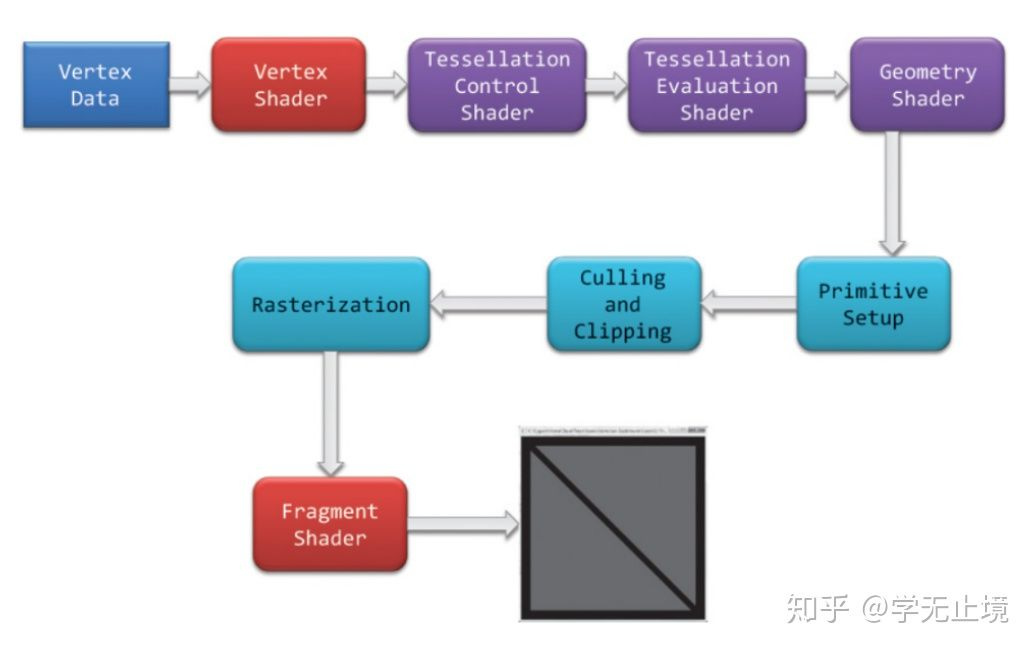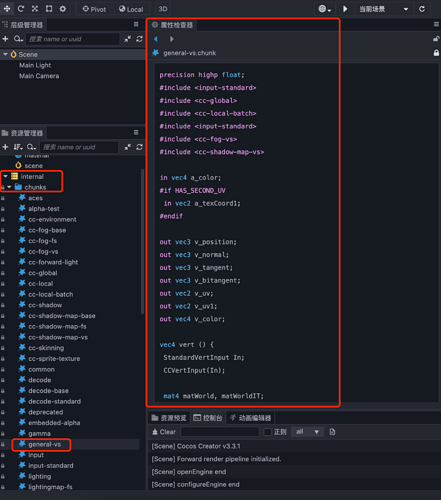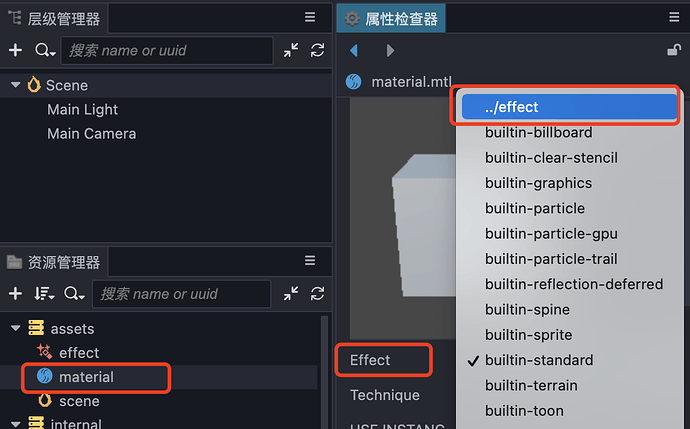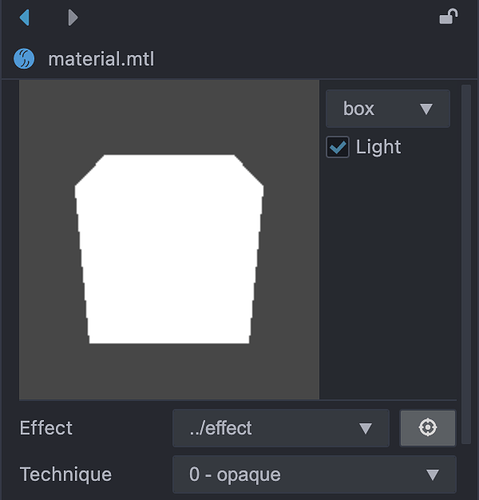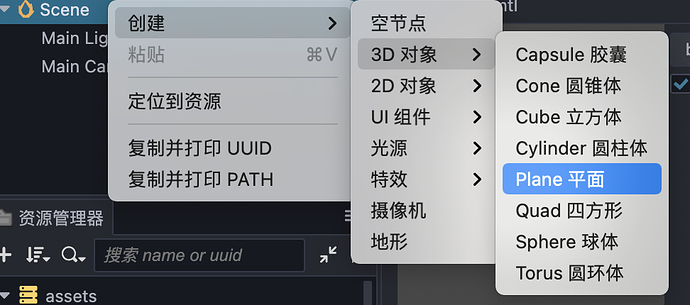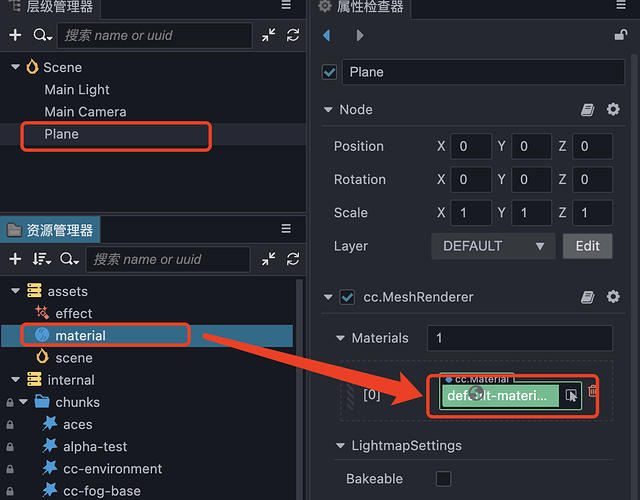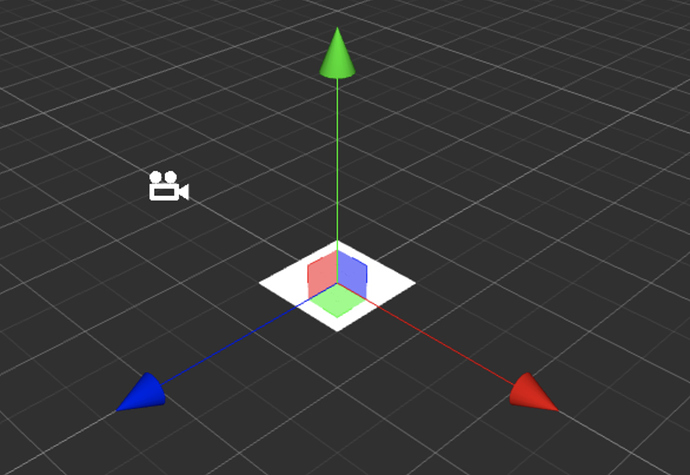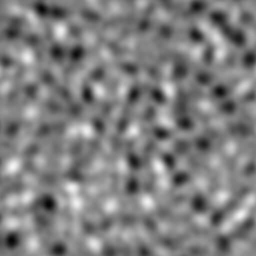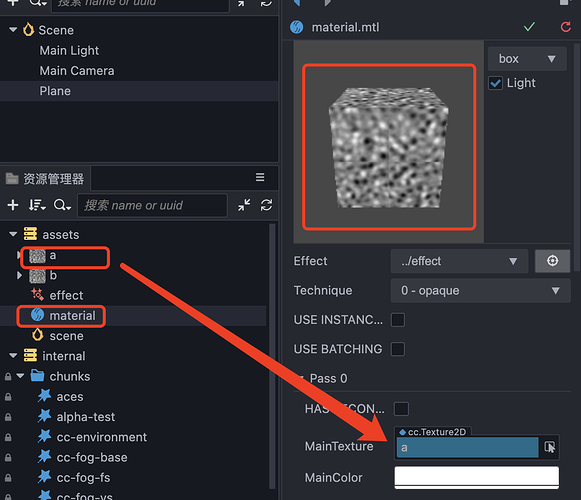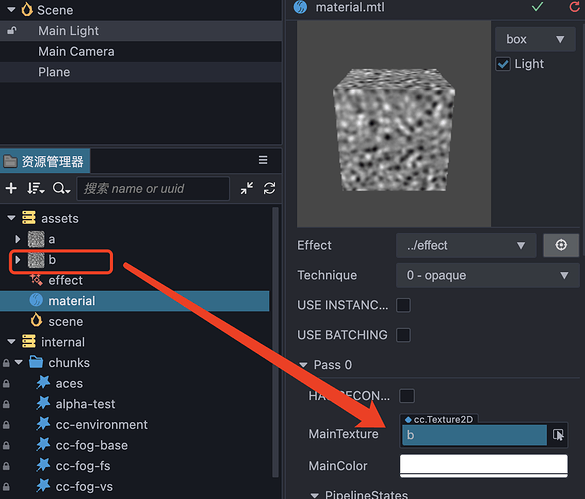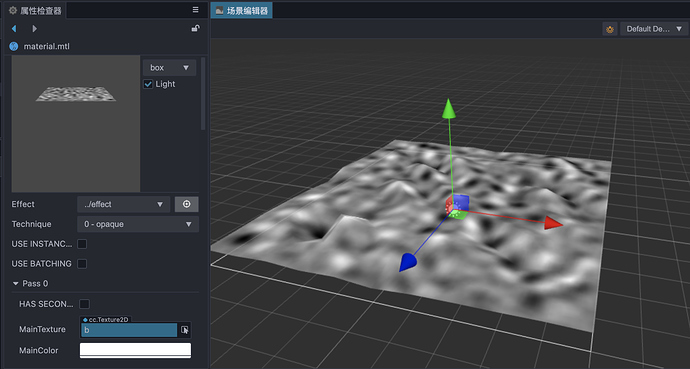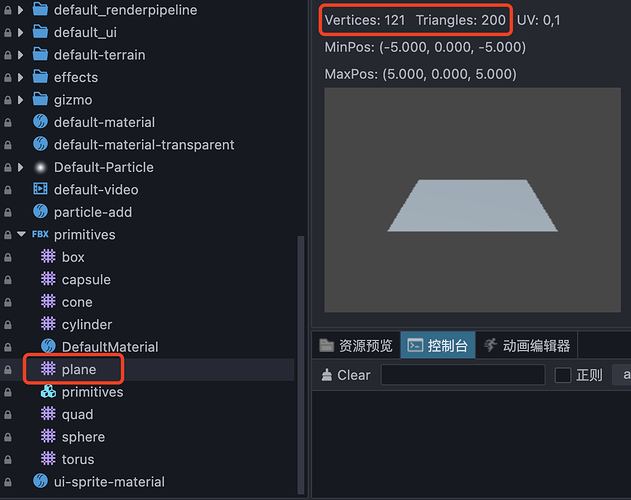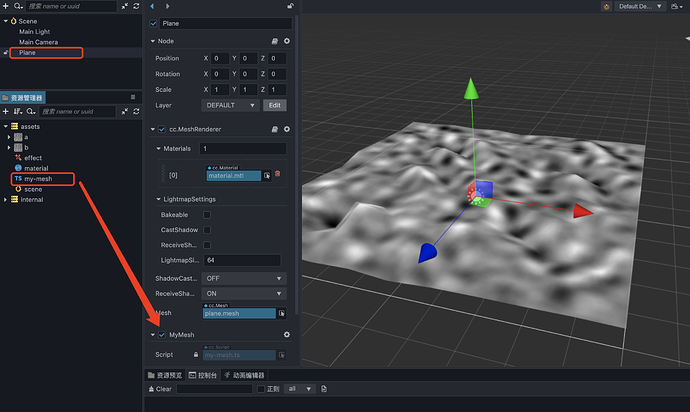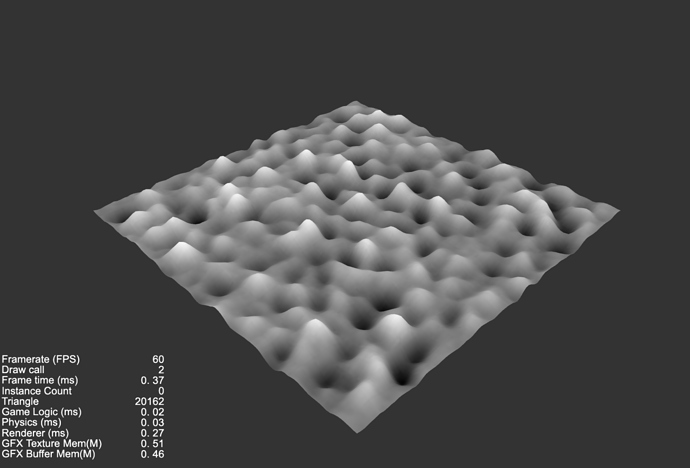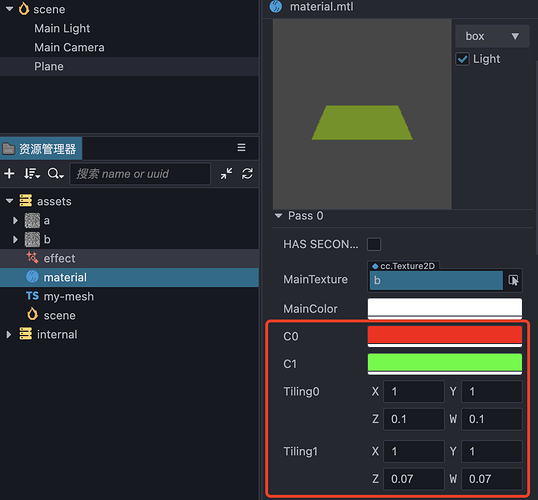0. 初衷
只是简单分享一下顶点着色器做的事情,和大概能做的事情
并不是真的想模拟一个真正的云海,毕竟对比RAYMarching体积云之类的效果来说还是差很多
这里用一个小demo,来一步步编写顶点着色器,实现修改模型的形状
一起来了解一下mesh模型,顶点着色器,片元着色器,噪声之间的作用
1.1 选用这个来作为开篇的理由很简单
- Mesh形状是矩形,只是当中三角形很多,所以很容易想象出结构
- 顶点着色器只修改了模型的Y轴,没有做过多的改变
- 顶点着色器的变化只是从噪声贴图中获取改怎么变,没有使用复杂的公式计算,所以也很容易想象
- 片元着色器更简单,只是返回了顶点着色器输出的v_color,顶点着色器输出的值会根据重心坐标进行差值
- 噪声是一个只有黑白灰的图片,所以也很容易理解
1. 效果预览
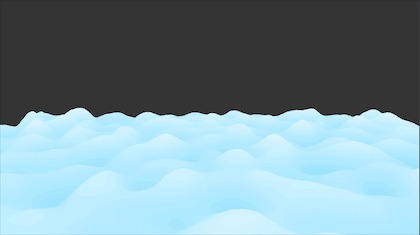
2. 思考
- GPU渲染的是一个一个的三角形
- 一个面只要顶点够多,就能生成一个平滑的曲面
– 在低端机可以让三角形【顶点】少一些 - 动态生成一个mesh,是一个平面,并且三角形足够的多
- 通过一张外部图片【噪声】的信息,来存储云的凹凸信息
– 一张图只有黑白灰,越白的地方,让三角形的高度越高,反之亦然 - 让这张贴图运动【滚动】起来,随着时间的变化,修改获取uv的位置信息
– 这样三角形就可以变化了 - 通过读取多张噪声,或者读取同一张噪声不同位置的地方,叠加起来,就可以获得翻涌的感觉了
3. 行动
多说无益,实践才是最好的
3.1 首先创建默认的场景,材质,和effect文件
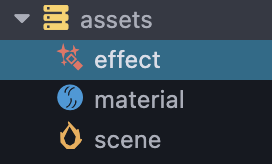
3.2 编辑effect文件
双击打开effect, 获得了默认的cocos的shader文件
// Effect Syntax Guide: https://github.com/cocos-creator/docs-3d/blob/master/zh/material-system/effect-syntax.md
CCEffect %{
techniques:
- name: opaque
passes:
- vert: general-vs:vert # builtin header
frag: unlit-fs:frag
properties: &props
mainTexture: { value: white }
mainColor: { value: [1, 1, 1, 1], editor: { type: color } }
- name: transparent
passes:
- vert: general-vs:vert # builtin header
frag: unlit-fs:frag
blendState:
targets:
- blend: true
blendSrc: src_alpha
blendDst: one_minus_src_alpha
blendSrcAlpha: src_alpha
blendDstAlpha: one_minus_src_alpha
properties: *props
}%
CCProgram unlit-fs %{
precision highp float;
#include <output>
#include <cc-fog-fs>
in vec2 v_uv;
uniform sampler2D mainTexture;
uniform Constant {
vec4 mainColor;
};
vec4 frag () {
vec4 col = mainColor * texture(mainTexture, v_uv);
CC_APPLY_FOG(col);
return CCFragOutput(col);
}
}%
可以看到一行
- vert: general-vs:vert # builtin header
根据后面的注释,可以知道,这里使用了默认的builtin的顶点着色器
参考cocos官方文档:
Effect Syntax · Cocos Creator
所以这个文件里面缺少了要编写的顶点着色器,所以要手动补充一个
找到自带的chunks里面的general-vs
将内容复制出来
回到effect文件中,补充一个
CCProgram块my-vs
CCProgram my-vs %{
precision highp float;
#include <input-standard>
#include <cc-global>
#include <cc-local-batch>
#include <input-standard>
#include <cc-fog-vs>
#include <cc-shadow-map-vs>
in vec4 a_color;
#if HAS_SECOND_UV
in vec2 a_texCoord1;
#endif
out vec3 v_position;
out vec3 v_normal;
out vec3 v_tangent;
out vec3 v_bitangent;
out vec2 v_uv;
out vec2 v_uv1;
out vec4 v_color;
vec4 vert () {
StandardVertInput In;
CCVertInput(In);
mat4 matWorld, matWorldIT;
CCGetWorldMatrixFull(matWorld, matWorldIT);
vec4 pos = matWorld * In.position;
v_position = pos.xyz;
v_normal = normalize((matWorldIT * vec4(In.normal, 0.0)).xyz);
v_tangent = normalize((matWorld * vec4(In.tangent.xyz, 0.0)).xyz);
v_bitangent = cross(v_normal, v_tangent) * In.tangent.w; // note the cross order
v_uv = a_texCoord;
#if HAS_SECOND_UV
v_uv1 = a_texCoord1;
#endif
v_color = a_color;
CC_TRANSFER_FOG(pos);
CC_TRANSFER_SHADOW(pos);
return cc_matProj * (cc_matView * matWorld) * In.position;
}
}%
并且将最上面的CCEffect的vert部分定义修改成
CCEffect %{
techniques:
- name: opaque
passes:
- vert: my-vs:vert # builtin header
frag: unlit-fs:frag
properties: &props
mainTexture: { value: white }
mainColor: { value: [1, 1, 1, 1], editor: { type: color } }
- name: transparent
passes:
- vert: general-vs:vert # builtin header
frag: unlit-fs:frag
blendState:
targets:
- blend: true
blendSrc: src_alpha
blendDst: one_minus_src_alpha
blendSrcAlpha: src_alpha
blendDstAlpha: one_minus_src_alpha
properties: *props
}%
3.3 绑定effect到材质上
选中材质,选择Effect,选中刚刚新建的effect文件,最后不要忘记点击右上角的箭头,保存一下
正确的话会预览出一个纯白的方块
3.4 创建plane,并应用材质
场景中创建3D对象,Plane
选中Plane节点,将material拖拽覆盖原本的default-material材质
最终可以得到一个纯白的Plane
3.5 准备噪声贴图
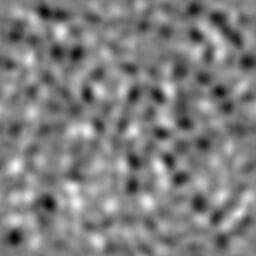
这里有两张噪声,简单看上去,他们好像并没有区别,但是如果让UV偏移0.5的话就会发生奇怪的问题
先简单修改下片元着色器,也就是frag块
CCProgram unlit-fs %{
precision highp float;
#include <output>
#include <cc-fog-fs>
in vec2 v_uv;
uniform sampler2D mainTexture;
uniform Constant {
vec4 mainColor;
};
vec4 frag () {
vec4 col = mainColor * texture(mainTexture, v_uv + 0.5);
CC_APPLY_FOG(col);
return CCFragOutput(col);
}
}%
3.5.1 修改了UV的取值
这里将v_uv增加了0.5
3.5.2 回到cocos creator编辑器,将两张噪声分别放进材质里,看看会发生什么
可以很明显的发现噪声在偏移之后,中间并不平滑
所以这里使用的噪声贴图有一个条件:无缝噪声
测试完记得吧+0.5删掉
测试完记得吧+0.5删掉
测试完记得吧+0.5删掉
3.6 修改顶点着色器,让顶点位置发生变化
uniform sampler2D mainTexture;
vec4 vert () {
StandardVertInput In;
CCVertInput(In);
mat4 matWorld, matWorldIT;
CCGetWorldMatrixFull(matWorld, matWorldIT);
vec4 p = In.position;
float y = texture(mainTexture, a_texCoord).x;
p.y = y;
vec4 pos = matWorld * p;
v_position = pos.xyz;
v_normal = normalize((matWorldIT * vec4(In.normal, 0.0)).xyz);
v_tangent = normalize((matWorld * vec4(In.tangent.xyz, 0.0)).xyz);
v_bitangent = cross(v_normal, v_tangent) * In.tangent.w; // note the cross order
v_uv = a_texCoord;
#if HAS_SECOND_UV
v_uv1 = a_texCoord1;
#endif
v_color = a_color;
CC_TRANSFER_FOG(pos);
CC_TRANSFER_SHADOW(pos);
return cc_matProj * (cc_matView * matWorld) * p;
}
3.6.1 定义mainTexture
uniform sampler2D mainTexture;
3.6.2 定义p = In.position; 并且用p代替后续代码中的In.position
3.6.3 读取mainTexture中对应UV位置的颜色,由于是黑白灰的噪声,所以r==g==b,直接将r的颜色赋值给p.y
3.6.4 后续不要忘记使用p来代替In.position来计算
回到cocos creator就可以发现Plane变的凹凸不平,并且越黑的地方越低,越白的地方越高
3.7 平滑
默认的Plane面数比较少,所以会变的比较不平滑
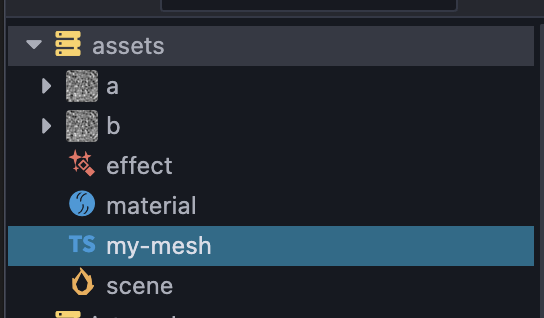
创建一个脚本,叫my-mesh,用来替换plane的默认mesh
import { _decorator, Component, utils, primitives, MeshRenderer } from 'cc';
const { ccclass, property } = _decorator;
@ccclass('MyMesh')
export class MyMesh extends Component {
start () {
const renderer = this.node.getComponent(MeshRenderer);
if(!renderer){
return;
}
const plane: primitives.IGeometry = primitives.plane({
width: 10,
length: 10
widthSegments: 100,
lengthSegments: 100,
});
renderer.mesh = utils.createMesh(plane);
}
}
回到Cocos,将脚本和Node绑定起来,并且运行
可以看到,相对编辑器中的已经平滑了许多,并且很容易的区分出高低的颜色
3.8 运动
引入时间戳(单位:s),根据时间的不同, 获取不同位置的uv信息,就可以让画面滚动起来
#incloud
uniform sampler2D mainTexture;
#include <cc-global>
vec4 vert () {
StandardVertInput In;
CCVertInput(In);
mat4 matWorld, matWorldIT;
CCGetWorldMatrixFull(matWorld, matWorldIT);
vec4 p = In.position;
float y = texture(mainTexture, a_texCoord + cc_time.x * 0.1).x;
p.y = y;
vec4 pos = matWorld * p;
v_position = pos.xyz;
v_normal = normalize((matWorldIT * vec4(In.normal, 0.0)).xyz);
v_tangent = normalize((matWorld * vec4(In.tangent.xyz, 0.0)).xyz);
v_bitangent = cross(v_normal, v_tangent) * In.tangent.w; // note the cross order
v_uv = a_texCoord;
#if HAS_SECOND_UV
v_uv1 = a_texCoord1;
#endif
v_color = a_color;
CC_TRANSFER_FOG(pos);
CC_TRANSFER_SHADOW(pos);
return cc_matProj * (cc_matView * matWorld) * p;
}
}%
3.8.1 引入 #incloud cc-global
3.8.2 修改 uv的获取,a_texCoord 值加上cc_time.x并且*一个速度系数0.1
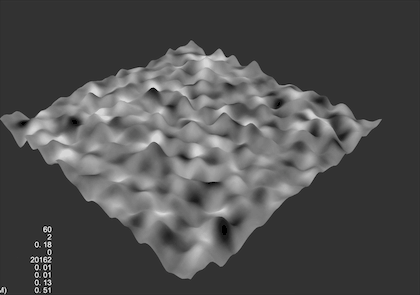
3.9 颜色
形状是发生改变了,但是颜色好像并没有重新发生变化
3.9.1 修改顶点着色器,将texture函数获取到的颜色,直接丢给v_color
3.9.2 修改片元着色器,直接将v_color颜色返回【记得先声明 in vec4 v_color;】
CCProgram my-vs %{
precision highp float;
#include <input-standard>
#include <cc-global>
#include <cc-local-batch>
#include <input-standard>
#include <cc-fog-vs>
#include <cc-shadow-map-vs>
in vec4 a_color;
#if HAS_SECOND_UV
in vec2 a_texCoord1;
#endif
out vec3 v_position;
out vec3 v_normal;
out vec3 v_tangent;
out vec3 v_bitangent;
out vec2 v_uv;
out vec2 v_uv1;
out vec4 v_color;
uniform sampler2D mainTexture;
#include <cc-global>
vec4 vert () {
StandardVertInput In;
CCVertInput(In);
mat4 matWorld, matWorldIT;
CCGetWorldMatrixFull(matWorld, matWorldIT);
vec4 p = In.position;
vec4 baseColor0 = texture(mainTexture, a_texCoord + cc_time.x * 0.1);
p.y = baseColor0.x;
vec4 pos = matWorld * p;
v_position = pos.xyz;
v_normal = normalize((matWorldIT * vec4(In.normal, 0.0)).xyz);
v_tangent = normalize((matWorld * vec4(In.tangent.xyz, 0.0)).xyz);
v_bitangent = cross(v_normal, v_tangent) * In.tangent.w; // note the cross order
v_uv = a_texCoord;
#if HAS_SECOND_UV
v_uv1 = a_texCoord1;
#endif
v_color = baseColor0;
CC_TRANSFER_FOG(pos);
CC_TRANSFER_SHADOW(pos);
return cc_matProj * (cc_matView * matWorld) * p;
}
}%
CCProgram unlit-fs %{
precision highp float;
#include <output>
#include <cc-fog-fs>
in vec2 v_uv;
in vec4 v_color;
uniform sampler2D mainTexture;
uniform Constant {
vec4 mainColor;
};
vec4 frag () {
return v_color;
}
}%
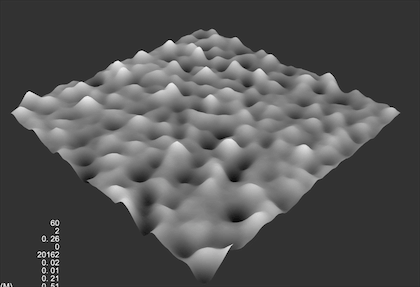
可以发现没有刚刚的问题了,回到越白的地方越高,越黑的地方越暗了
3.10 噪声叠加【翻涌】
噪声可以用多张,也可以读取多次,只要读取的位置不一样,并且叠加起来,那么就可以得到翻涌的感觉了
说上来可以比较抽象,实际行动下
vec4 vert () {
StandardVertInput In;
CCVertInput(In);
mat4 matWorld, matWorldIT;
CCGetWorldMatrixFull(matWorld, matWorldIT);
vec4 p = In.position;
vec4 tiling0 = vec4(1.0, 1.0, 0.1, 0.1);
vec4 tiling1 = vec4(1.0, 1.0, 0.07, 0.07);
vec4 baseColor0 = texture(mainTexture, a_texCoord * tiling0.xy + cc_time.x * tiling0.zw);
vec4 baseColor1 = texture(mainTexture, a_texCoord * tiling1.xy + cc_time.x * tiling1.zw);
p.y = (baseColor0.x + baseColor1.x) * 0.5 - 0.5;
vec4 pos = matWorld * p;
v_position = pos.xyz;
v_normal = normalize((matWorldIT * vec4(In.normal, 0.0)).xyz);
v_tangent = normalize((matWorld * vec4(In.tangent.xyz, 0.0)).xyz);
v_bitangent = cross(v_normal, v_tangent) * In.tangent.w; // note the cross order
v_uv = a_texCoord;
#if HAS_SECOND_UV
v_uv1 = a_texCoord1;
#endif
v_color = (baseColor0 + baseColor1)* 0.5;
CC_TRANSFER_FOG(pos);
CC_TRANSFER_SHADOW(pos);
return cc_matProj * (cc_matView * matWorld) * p;
}
3.10.1 定义了tiling0和tiling1,其中,xy用来控制uv的倍率,zw用来控制uv移动的方向
3.10.2 texture采样两次,分别为baseColor0何baseColor1,并且两个颜色的红色加起来*0.5,赋值给p.y
3.10.3 p.y最后还- 0.5,是因为y的值原本在0~1之间,希望最后在-0.5~0.5之间分布,所以整体-0.5
3.10.4 将v_color = baseColor0改成v_color = (baseColor0 + baseColor1)* 0.5;
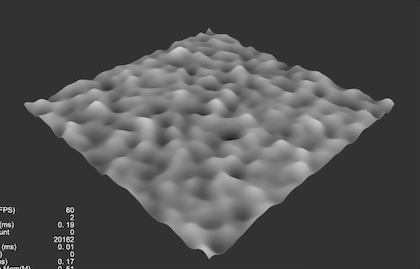
可以发现运动不再和上面一样单一运动,而是带上起伏的感觉
3.11 颜色过渡
黑白灰毕竟不好看,所以希望自定义两个颜色来重新定义高低
vec4 c0 = vec4(1.0, 0.0, 0.0, 1.0);
vec4 c1 = vec4(0.0, 1.0, 0.0, 1.0);
v_color = (p.y + 0.5) * (c0 - c1) + c1;
定义两个颜色c0和c1,用来表示最高处和最低处的两个地方的颜色
c0表示最高处的颜色
c1表示最低处的颜色
c0 - c1= 两个颜色的差距
p.y + 0.5得到一个0~1之间的值,用来表示当前y的高度
(p.y + 0.5) * (c0 - c1)得到一个y高度变化中的过渡值
过渡值+c1,表示过渡值+基础值=最终的颜色
c0 - c1等于两个颜色分量的差,用差*(y + 0.5)得到变化值,最后在加上c1
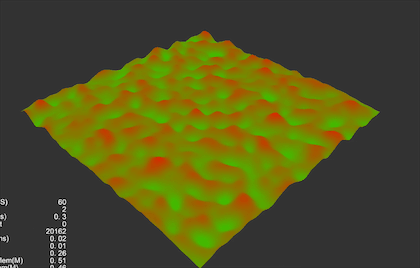
这样就得到了一个自定义颜色的shader
3.12 将定义的数据暴露给材质面板
目前位置,这里定义了两个tiling,两个颜色c0和c1
CCEffect %{
techniques:
- name: opaque
passes:
- vert: my-vs:vert # builtin header
frag: unlit-fs:frag
properties: &props
mainTexture: { value: white }
mainColor: { value: [1, 1, 1, 1], editor: { type: color } }
c0: { value: [1, 0, 0, 1], editor: { type: color } }
c1: { value: [0, 1, 0, 1], editor: { type: color } }
tiling0: { value: [1.0, 1.0, 0.1, 0.1] }
tiling1: { value: [1.0, 1.0, 0.07, 0.07] }
- name: transparent
passes:
- vert: general-vs:vert # builtin header
frag: unlit-fs:frag
blendState:
targets:
- blend: true
blendSrc: src_alpha
blendDst: one_minus_src_alpha
blendSrcAlpha: src_alpha
blendDstAlpha: one_minus_src_alpha
properties: *props
}%
将c0, c1, tiling0, tiling1定义到properties里面,原来的参数这里先不做任何删改,保留处理
给顶点着色器和片元着色器都加上uniform声明定义块
uniform MyVec4 {
vec4 c0;
vec4 c1;
vec4 tiling0;
vec4 tiling1;
};
然后移除原本代码里面定义的c0, c1, tiling0和tiling1,用uniform来代替
最终完整的effect文件内容为:
// Effect Syntax Guide: https://github.com/cocos-creator/docs-3d/blob/master/zh/material-system/effect-syntax.md
CCEffect %{
techniques:
- name: opaque
passes:
- vert: my-vs:vert # builtin header
frag: unlit-fs:frag
properties: &props
mainTexture: { value: white }
mainColor: { value: [1, 1, 1, 1], editor: { type: color } }
c0: { value: [1, 0, 0, 1], editor: { type: color } }
c1: { value: [0, 1, 0, 1], editor: { type: color } }
tiling0: { value: [1.0, 1.0, 0.1, 0.1] }
tiling1: { value: [1.0, 1.0, 0.07, 0.07] }
- name: transparent
passes:
- vert: general-vs:vert # builtin header
frag: unlit-fs:frag
blendState:
targets:
- blend: true
blendSrc: src_alpha
blendDst: one_minus_src_alpha
blendSrcAlpha: src_alpha
blendDstAlpha: one_minus_src_alpha
properties: *props
}%
CCProgram my-vs %{
precision highp float;
#include <input-standard>
#include <cc-global>
#include <cc-local-batch>
#include <input-standard>
#include <cc-fog-vs>
#include <cc-shadow-map-vs>
in vec4 a_color;
#if HAS_SECOND_UV
in vec2 a_texCoord1;
#endif
out vec3 v_position;
out vec3 v_normal;
out vec3 v_tangent;
out vec3 v_bitangent;
out vec2 v_uv;
out vec2 v_uv1;
out vec4 v_color;
uniform sampler2D mainTexture;
uniform MyVec4 {
vec4 c0;
vec4 c1;
vec4 tiling0;
vec4 tiling1;
};
#include <cc-global>
vec4 vert () {
StandardVertInput In;
CCVertInput(In);
mat4 matWorld, matWorldIT;
CCGetWorldMatrixFull(matWorld, matWorldIT);
vec4 p = In.position;
vec4 baseColor0 = texture(mainTexture, a_texCoord * tiling0.xy + cc_time.x * tiling0.zw);
vec4 baseColor1 = texture(mainTexture, a_texCoord * tiling1.xy + cc_time.x * tiling1.zw);
p.y = (baseColor0.x + baseColor1.x) * 0.5 - 0.5;
vec4 pos = matWorld * p;
v_position = pos.xyz;
v_normal = normalize((matWorldIT * vec4(In.normal, 0.0)).xyz);
v_tangent = normalize((matWorld * vec4(In.tangent.xyz, 0.0)).xyz);
v_bitangent = cross(v_normal, v_tangent) * In.tangent.w; // note the cross order
v_uv = a_texCoord;
#if HAS_SECOND_UV
v_uv1 = a_texCoord1;
#endif
v_color = (p.y + 0.5) * (c0 - c1) + c1;
CC_TRANSFER_FOG(pos);
CC_TRANSFER_SHADOW(pos);
return cc_matProj * (cc_matView * matWorld) * p;
}
}%
CCProgram unlit-fs %{
precision highp float;
#include <output>
#include <cc-fog-fs>
in vec2 v_uv;
in vec4 v_color;
uniform sampler2D mainTexture;
uniform Constant {
vec4 mainColor;
};
uniform MyVec4 {
vec4 c0;
vec4 c1;
vec4 tiling0;
vec4 tiling1;
};
vec4 frag () {
return v_color;
}
}%
回到cocos中,查看材质
4. 成果
调整一下摄像机,材质的参数

4.1 最小可预览工程
版本:CocosCreator 3.3.1
learn.zip (45.8 KB)
Other 软件渲染器
https://github.com/Jecced/raster

